Teaching, implementing a swarming match-up zone defense
The premise of a match-up zone defense is to manipulate the opponent into executing its zone offense versus — for all intents and purposes — a man-to-man defense.
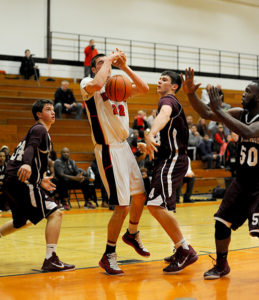 Zone offenses are predictable. Teams, for example, almost always attack a 2-3 zone with either a 1-3-1 or a 1-2-2 offensive attack. A match-up defense essentially eliminates the opponent’s arsenal of set plays or cutters by switching all player movements. It’s also versatile and can work from any defensive alignment that you choose (2-3, 1-3-1, 1-2-2, 3-2, etc.).
Zone offenses are predictable. Teams, for example, almost always attack a 2-3 zone with either a 1-3-1 or a 1-2-2 offensive attack. A match-up defense essentially eliminates the opponent’s arsenal of set plays or cutters by switching all player movements. It’s also versatile and can work from any defensive alignment that you choose (2-3, 1-3-1, 1-2-2, 3-2, etc.).
Defenders in the match-up are responsible for a designated man, contrary to zone responsibilities in which defenders are assigned to defend a pre-determined area.
- X1 sets the tone. X1 is the most important defender on the floor. This player’s defensive actions dictate the defensive assignments of the other four defenders.
- Automatically switch on screens. If an offense attempts to screen the match-up, the defenders should automatically switch.
- Jam cutters. All cutters must be jammed so that their timing and movements are severely disrupted.
- Communicate. Defenders must talk to one another. Communication is critical in making the match-up defense successful. Any time an offensive player cuts through the “match-up” area, all five defenders must talk to one another and determine new assignments.
- Deception is key. The foundation of the match-up defense is to show a zone defensive look while playing man-to-man principles.
Match-up alignments
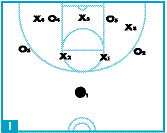
DIAGRAM 1: 2-3 Match-up zone defense vs. 1-2-2 offense.
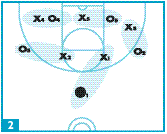
DIAGRAM 2: 2-3 match-up zone vs. 1-2-2 offense (with assignments).

DIAGRAM 3: 2-3 match-up zone vs. 1-3-1 offense.

DIAGRAM 4: 1-3-1 match-up zone vs. 2-1-2 offense.

DIAGRAM 5: 1-2-2 match-up zone vs. 2-1-2 offense.
Individual defensive assignments
• Defender X1. This player should be your point guard and is the most important defender in the match-up defense. This player is the “quarterback” of your defense.
Again, X1 assumes initial ball responsibility and the defensive assignments of the other four players are dictated by his or her movements.
• Defender X2. This player is usually your shooting guard. X2 always assumes responsibility for the first offensive player to his or her right of X1 (defensive point guard).
• Defender X3. The small forward X3 usually possesses decent rebounding skills. X3 assumes defensive responsibility for the first offensive player to the left of X1.
• Defender X4. One of the two post defenders, X4 plays man-to-man defense for the entire possession against the second offensive player to the right of X1.
• Defender X5. The other post defender, X5 plays man-to-man defense against the second offensive player to the left of X1. (Note: If the offense puts a post at the high post X5 always takes him).
How it works
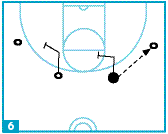
DIAGRAM 6: 2-3 match-up vs. player movements and cutters. When O1 passes to O2 and then interchanges with O3, X1 must now guard O3. X2 then guards O1. X1 is matched with O3 and is playing man-to-man during the entire possession.
X5, just as the rule dictates, becomes matched up with O5. He or she stays with O5 as the player cuts to the ball-side block.

DIAGRAM 7: 2-3 match-up vs. cutters (A). O1 hits O2 and cuts through to the ball-side corner to distort the zone (this becomes a “corner call” by the match-up).

DIAGRAM 8: 2-3 Match-up vs. cutters (B). X3 defends O2 until X1 “bumps” him or her off. X1 then defends O2, X3 guards O1, X2 remains on O3, X4 has O4, and X5 guards O5.
Note: On the initial cut by O1, X1 jams O1 to disrupt the cut.
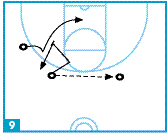 DIAGRAM 9: 2-3 match-up vs. cutter from the wing (A). These are the initial 2-3 match-ups.
DIAGRAM 9: 2-3 match-up vs. cutter from the wing (A). These are the initial 2-3 match-ups.

DIAGRAM 10: 2-3 match-up vs. cutter from the wing (B). On the pass from O1 to O2, O3 cuts to ball-side corner for shot. X3 must jam O3 to disrupt the timing of the cut.

DIAGRAM 11: 2-3 match-up vs. cutter from rhe wing (C). This is another corner call. X2 defends O2 until “bumped” by X1. X2 now takes O3, X1 takes O2, and X3 takes O1.
Match-up vs. weak-side cutter
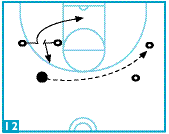
DIAGRAM 12: 2-3 match-up vs. cutter to the weak side (A).
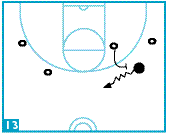
DIAGRAM 13: 2-3 Match-up vs. cutter to the weak side (B). O1 hits O3 and cuts through to the weak side. O5 rolls to the ball-side block, while O4 flashes to high post.
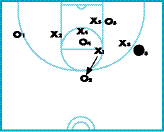
DIAGRAM 14: 2-3 match-up vs. cutter to the weak side (C). After X1 jams O1 on the cut, he or she absorbs O2. X2 defends O1 on the weak-side cut.









